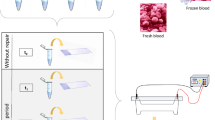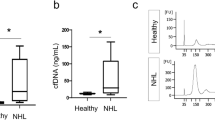Abstract
Phosphorylation of H2AX histone (γH2AX) represents an early event in the DNA damage response against double-strand breaks (DSB); hence, its measurement provides a surrogate biomarker of DSB. Recently, we reported initial steps in the standardization of γH2AX assay in peripheral blood leukocytes (PBL), addressing the possibility of using cryopreserved samples, and the need of phytohaemagglutinin (PHA) stimulation prior analysis (Toxicol Sci 2015, 144:406-13). Validating the use of whole blood samples as cell specimen for this assay would be particularly useful for human population studies. Hence, in the current study we determined for the first time the feasibility of whole blood samples, both fresh and frozen, to be used in the γH2AX assay, evaluated by flow cytometry, and the convenience of PHA stimulation. Freshly collected and cryopreserved whole blood samples were treated with bleomycin (BLM), actinomycin-D (Act-D) and mitomycin C (MMC); half of the samples were previously incubated with PHA. Results were compared with those from PBL. Negative responses in MMC treatments were probably due to the quiescence of unstimulated cells, or to the short treatment time in PHA stimulated cells. Fresh whole blood samples exhibited a more intense response to BLM and Act-D treatments in stimulated cells, probably due to DSB indirectly produced from other less relevant types of DNA damage. Results obtained in frozen whole blood samples indicate that PHA stimulation is not advisable. In conclusion, this study demonstrates that whole blood samples can be used to assess DSB-related genotoxicity by the flow cytometry γH2AX assay.





Similar content being viewed by others
Data availability
Not applicable.
Code availability
Not applicable.
References
Al-Minawi AZ, Lee YF, Håkansson D, Johansson F, Lundin C, Saleh-Gohari N, Schultz N, Jenssen D, Bryant HE, Meuth M, Hinz JM, Helleday T (2009) The ERCC1/XPF endonuclease is required for completion of homologous recombination at DNA replication forks stalled by inter-strand cross-links. Nucleic Acids Res 37:6400–6413. https://doi.org/10.1093/nar/gkp705
Avendaño C, Menéndez JC (2015) Anticancer drugs that interact with the DNA minor groove. In: Medicinal chemistry of anticancer drugs. Elsevier, pp 243–271. https://doi.org/https://doi.org/10.1016/B978-0-444-62649-3.00006-5
Banáth JP, Klokov D, MacPhail SH, Banuelos CA, Olive PL (2010) Residual γH2AX foci as an indication of lethal DNA lesions. BMC Cancer 10:4. https://doi.org/10.1186/1471-2407-10-4
Bensaude O (2011) Inhibiting eukaryotic transcription: Which compound to choose? How to evaluate its activity? Transcription 2:103–108. https://doi.org/10.4161/trns.2.3.16172
Bonner WM, Redon CE, Dickey JS, Nakamura AJ, Sedelnikova OA, Solier S, Pommier Y (2008) γH2AX and cancer. Nat Rev Cancer 8:957–967. https://doi.org/10.1038/nrc2523
Chen J, Stubbe J (2005) Bleomycins: towards better therapeutics. Nat Rev Cancer 5:102–112. https://doi.org/10.1038/nrc1547
Giunta S, Jackson SP (2011) Give me a break, but not in mitosis: the mitotic DNA damage response marks DNA double strand breaks with early signaling events. Cell Cycle 10:1215–1221. https://doi.org/10.4161/cc.10.8.15334
Hamasaki K, Imai K, Nakachi K, Takahashi N, Kodama Y, Kusunoki Y (2007) Short-term culture and γH2AX flow cytometry determine differences in individual radiosensitivity in human peripheral T lymphocytes. Environ Mol Mutagen 48:38–47. https://doi.org/10.1002/em.20273
Hu J, Hu S, Ma Q, Wang X, Zhou Z, Zhang W, Sun X, Zhu W, Qian H, Xu W (2012) Immortalized mouse fetal liver stromal cells support growth and maintenance of human embryonic stem cells. Oncol Rep 28:1385–1391. https://doi.org/10.3892/or.2012.1909
Kataria SK, Chhillar AK, Kumar A, Tomar M, Malik V (2016) Cytogenetic and hematological alterations induced by acute oral exposure of imidacloprid in female mice. Drug Chem Toxicol 39:59–65. https://doi.org/10.3109/01480545.2015.1026972
Kathiravan MK, Khilare MM, Nikoomanesh K, Chothe AS, Jain KS (2013) Topoisomerase as target for antibacterial and anticancer drug discovery. J Enzyme Inhib Med Chem 28:419–435. https://doi.org/10.3109/14756366.2012.658785
Khoury L, Zalko D, Audebert M (2020) Evaluation of the genotoxic potential of apoptosis inducers with the γH2AX assay in human cells. Mutat Res - Genet Toxicol Environ Mutagen 852:1–10. https://doi.org/10.1016/j.mrgentox.2020.503165
Laffon B, Fernández-Bertólez N, Costa C, Pásaro E, Valdiglesias V (2017) Comparative study of human neuronal and glial cell sensitivity for in vitro neurogenotoxicity testing. Food Chem Toxicol 102:120–128. https://doi.org/10.1016/j.fct.2017.02.005
Laffon B, Valdiglesias V, Pásaro E, Méndez J (2010) The organic selenium compound selenomethionine modulates bleomycin-induced DNA damage and repair in human leukocytes. Biol Trace Elem Res 133:12–19. https://doi.org/10.1007/s12011-009-8407-9
Limoli CL, Giedzinski E, Bonner WM, Cleaver JE (2002) UV-induced replication arrest in the xeroderma pigmentosum variant leads to DNA doublestrand breaks, γ-H2AX formation, and Mre11 relocalization. Proc Natl Acad Sci USA 99:233–238. https://doi.org/10.1073/pnas.231611798
Liu M, Hales BF, Robaire B (2014) Effects of four chemotherapeutic agents, bleomycin, etoposide, cisplatin, and cyclophosphamide, on DNA damage and telomeres in a mouse spermatogonial cell line. Biol Reprod 90:1–10. https://doi.org/10.1095/biolreprod.114.117754
Milić M, Kopjar N (2004) Evaluation of in vitro genotoxic activity of bleomycin and mitomycin C in human lymphocytes using the alkaline comet assay. In: Arhiv za Higijenu Rada i Toksikologiju. pp 249–259
Mischo HE, Hemmerich P, Grosse F, Zhang S (2005) Actinomycin D induces histone γ-H2AX foci and complex formation of γ-H2AX with Ku70 and nuclear DNA helicase II. J Biol Chem 280:9586–9594. https://doi.org/10.1074/jbc.M411444200
Niedernhofer LJ, Odijk H, Budzowska M, van Drunen E, Maas A, Theil AF, de Wit J, Jaspers NGJ, Beverloo HB, Hoeijmakers JHJ, Kanaar R (2004) The structure-specific endonuclease Ercc1-Xpf is required to resolve DNA interstrand cross-link-induced double-strand breaks. Mol Cell Biol 24:5776–5787. https://doi.org/10.1128/mcb.24.13.5776-5787.2004
Nikolova T, Dvorak M, Jung F, Adam I, Krämer E, Gerhold-Ay A, Kaina B (2014) The γH2AX assay for genotoxic and nongenotoxic agents: comparison of H2AX phosphorylation with cell death response. Toxicol Sci 140:103–117. https://doi.org/10.1093/toxsci/kfu066
Paull TT, Rogakou EP, Yamazaki V, Kirchgessner CU, Gellert M, Bonner WM (2000) A critical role for histone H2AX in recruitment of repair factors to nuclear foci after DNA damage. Curr Biol 10:886–895. https://doi.org/10.1016/S0960-9822(00)00610-2
Porcedda P, Turinetto V, Lantelme E, Fontanella E, Chrzanowska K, Ragona R, De Marchi M, Delia D, Giachino C (2006) Impaired elimination of DNA double-strand break-containing lymphocytes in ataxia telangiectasia and Nijmegen breakage syndrome. DNA Repair (Amst) 5:904–913. https://doi.org/10.1016/j.dnarep.2006.05.002
Povirk LF, Austin FMJ (1991) Genotoxicity of bleomycin. Mutat Res Genet Toxicol 257:127–143. https://doi.org/10.1016/0165-1110(91)90022-N
Rogakou EP, Pilch DR, Orr AH, Ivanova VS, Bonner WM (1998) DNA double-stranded breaks induce histone H2AX phosphorylation on serine 139. J Biol Chem 273:5858–5868. https://doi.org/10.1074/jbc.273.10.5858
Rogakou EP, Sekeri-Pataryas KE (1999) Histone variants of H2A and H3 families are regulated during in vitro aging in the same manner as during differentiation. Exp Gerontol 34:741–754. https://doi.org/10.1016/S0531-5565(99)00046-7
Roh DS, Cook AL, Rhee SS, Joshi A, Kowalski R, Dhaliwal DK, Funderburgh JL (2008) DNA cross-linking, double-strand breaks, and apoptosis in corneal endothelial cells after a single exposure to mitomycin C. Investig Opthalmology Vis Sci 49:4837. https://doi.org/https://doi.org/10.1167/iovs.08-2115
Ross WE, Bradley MO (1981) DNA double-strand breaks in mammalian cells after exposure to intercalating agents. BBA Sect Nucleic Acids Protein Synth 654:129–134. https://doi.org/10.1016/0005-2787(81)90145-3
Rothkamm K, Löbrich M (2003) Evidence for a lack of DNA double-strand break repair in human cells exposed to very low x-ray doses. Proc Natl Acad Sci USA 100:5057–5062. https://doi.org/10.1073/pnas.0830918100
Sánchez-Flores M, Pásaro E, Bonassi S, Laffon B, Valdiglesias V (2015) γH2AX assay as DNA damage biomarker for human population studies: defining experimental conditions. Toxicol Sci 144:406–413. https://doi.org/10.1093/toxsci/kfv011
Scarpato R, Verola C, Fabiani B, Bianchi V, Saggese G, Federico G (2011) Nuclear damage in peripheral lymphocytes of obese and overweight Italian children as evaluated by the γ-H2AX focus assay and micronucleus test. FASEB J 25:685–693. https://doi.org/10.1096/fj.10-168427
Smart DJ, Ahmedi KP, Harvey JS, Lynch AM (2011) Genotoxicity screening via the γH2AX by flow assay. Mutat Res—Fundam Mol Mech Mutagen 715:25–31. https://doi.org/10.1016/j.mrfmmm.2011.07.001
Sobell HM (1985) Actinomycin and DNA transcription. Proc Natl Acad Sci USA 82:5328–5331. https://doi.org/10.1073/pnas.82.16.5328
Stucki M, Clapperton JA, Mohammad D, Yaffe MB, Smerdon SJ, Jackson SP (2005) MDC1 directly binds phosphorylated histone H2AX to regulate cellular responses to DNA double-strand breaks. Cell 123:1213–1226. https://doi.org/10.1016/j.cell.2005.09.038
Tanaka T, Halicka D, Traganos F, Darzynkiewicz Z (2009) Cytometric analysis of DNA damage: Phosphorylation of histone H2AX as a marker of DNA double-strand breaks (DSBs). In: Methods Mol Biol. pp 161–168. https://doi.org/https://doi.org/10.1007/978-1-59745-190-1_11
Tewey KM, Rowe TC, Yang L, Halligan BD, Liu LF (1984) Adriamycin-induced DNA damage mediated by mammalian DNA topoisomerase II. Science 226:466–468. https://doi.org/10.1126/science.6093249
Tian M, Feng Y, Min J, Gong W, Xiao W, Li X, Tao D, Hu J, Gong J (2011) DNA damage response in resting and proliferating peripheral blood lymphocytes treated by camptothecin or X-ray. J Huazhong Univ Sci Technol—Med Sci 31:147–153. https://doi.org/10.1007/s11596-011-0241-6
Trask DK, Muller MT (1988) Stabilization of type I topoisomerase-DNA covalent complexes by actinomycin D. Proc Natl Acad Sci USA 85:1417–1421. https://doi.org/10.1073/pnas.85.5.1417
Valdiglesias V, Costa C, Sharma V, Kiliç G, Pásaro E, Teixeira JP, Dhawan A, Laffon B (2013a) Comparative study on effects of two different types of titanium dioxide nanoparticles on human neuronal cells. Food Chem Toxicol J 57:352–361. https://doi.org/10.1016/j.fct.2013.04.010
Valdiglesias V, Giunta S, Fenech M, Neri M, Bonassi S (2013b) γH2AX as a marker of DNA double strand breaks and genomic instability in human population studies. Mutat Res Mutat Res 753:24–40. https://doi.org/10.1016/j.mrrev.2013.02.001
Valdiglesias V, Laffon B, Pasaro E, Mendez J (2011) Evaluation of okadaic acid-induced genotoxicity in human cells using the micronucleus test and γH2AX analysis. J Toxicol Environ Heal—Part A Curr Issues 74:980–992. https://doi.org/10.1080/15287394.2011.582026
Wassermann K, Markovits J, Jaxel C, Capranico G, Kohn KW, Pommier Y (1990) Effects of morpholinyl doxorubicins, doxorubicin, and Actinomycin D on mammalian DNA topoisomerases I and II. Mol Pharmacol 38:38–45
Watters GP, Smart DJ, Harvey JS, Austin CA (2009) H2AX phosphorylation as a genotoxicity endpoint. Mutat Res Toxicol Environ Mutagen 679:50–58. https://doi.org/10.1016/j.mrgentox.2009.07.007
Yamamoto KN, Hirota K, Kono K, Takeda S, Sakamuru S, Xia M, Huang R, Austin CP, Witt KL, Tice RR (2011) Characterization of environmental chemicals with potential for DNA damage using isogenic DNA repair-deficient chicken DT40 cell lines. Environ Mol Mutagen 52:547–561. https://doi.org/10.1002/em.20656
Zhou C, Li Z, Diao H, Yu Y, Zhu W, Dai Y, Chen FF, Yang J (2006) DNA damage evaluated by γH2AX foci formation by a selective group of chemical/physical stressors. Mutat Res—Genet Toxicol Environ Mutagen 604:8–18. https://doi.org/10.1016/j.mrgentox.2005.12.004
Funding
This work was supported by Xunta de Galicia [ED431B 2019/02], Ministerio de Educación, Cultura y Deporte [BEAGAL18/00142 to V.V], and Deputación Provincial de A Coruña [to M.S.-F. and N.F.-B.].
Author information
Authors and Affiliations
Corresponding author
Ethics declarations
Conflicts of interest
The authors declare that they have no conflict of interest.
Ethics approval
The manuscript does not contain clinical studies or patient data.
Consent to participate
All volunteers gave their informed consent prior to their inclusion in the study.
Consent for publication
Not applicable.
Additional information
Publisher's Note
Springer Nature remains neutral with regard to jurisdictional claims in published maps and institutional affiliations.
Rights and permissions
About this article
Cite this article
Laffon, B., Sánchez-Flores, M., Fernández-Bertólez, N. et al. Applicability of flow cytometry γH2AX assay in population studies: suitability of fresh and frozen whole blood samples. Arch Toxicol 95, 1843–1851 (2021). https://doi.org/10.1007/s00204-021-03009-z
Received:
Accepted:
Published:
Issue Date:
DOI: https://doi.org/10.1007/s00204-021-03009-z




